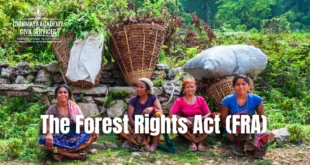A Sufi Samvad (Sufi Dialogue) programme was launched by a political party as a means of reaching out to the Muslim community.
Key details:
- It is a year-long programme.
- It will end with a big meeting set to be addressed by Prime Minister of India.
- The idea of the programme is to go among the Muslim community, bring to their notice the fact that the government had worked for all, irrespective of caste, creed or community.
- Most of the programmes will be aimed at Muslim-majority areas and districts where there are up to 20% or more Muslim population.
Sneh Milan:
Another programme being launched is the “sneh milan” goodwill meeting with Muslim community members, with the slogan “one nation, one DNA”.
Eurasian otter
Context: The first photographic record of Eurasian otter has indicated that some stretches of the Neeru remain unpolluted.
The Neeru river:
- The Neeru is a tributary of the Chenab river.
- These stretches comprise stony beds and narrow valleys.
- Neeru river originates from the Sonabain Glacier in Bhaderwah of Jammu and Kashmir.
- It flows through Bhaderwah valley and joins river Chenab at Pul Doda.
- The Gupt Ganga temple of Bhaderwah is located on the bank of this river.
The Eurasian Otter
- The Eurasian otter is a semiaquatic mammal native to Eurasia.
- The Eurasian otter has one of the widest distributions of all palaearctic mammals.
Its range covers parts of three continents:
- Europe,
- Asia and
- In India, it occurs in northern, northeast and southern India.
- Formerly widely distributed in Japan, it is now believed to be extinct there.
Habitat:
- The Eurasian otter lives in a wide variety of aquatic habitats, including highland and lowland lakes, rivers, streams, marshes, swamp forests and coastal areas.
- In the Indian sub-continent, Eurasian otters occur in cold hill and mountain streams.
Major Threats:
- Habitat destruction due to developmental activities.
- Decrease in prey species due to acidification of rivers and lakes.
- Coastal populations are vulnerable to oil spills.
- Inland populations are vulnerable to organic pollution by nitrate fertilizers, untreated sewage, or farm slurry.
- Traps designed to kill other species, especially underwater cages constructed to drown muskrats.
Conservation status:
IUCN : Near threatened
Indian Wildlife Protection Act : Schedule II
CITES : Appendix I
SOURCE: THE HINDU, THE ECONOMIC TIMES, PIB
 Chinmaya IAS Academy – Current Affairs Chinmaya IAS Academy – Current Affairs
Chinmaya IAS Academy – Current Affairs Chinmaya IAS Academy – Current Affairs



